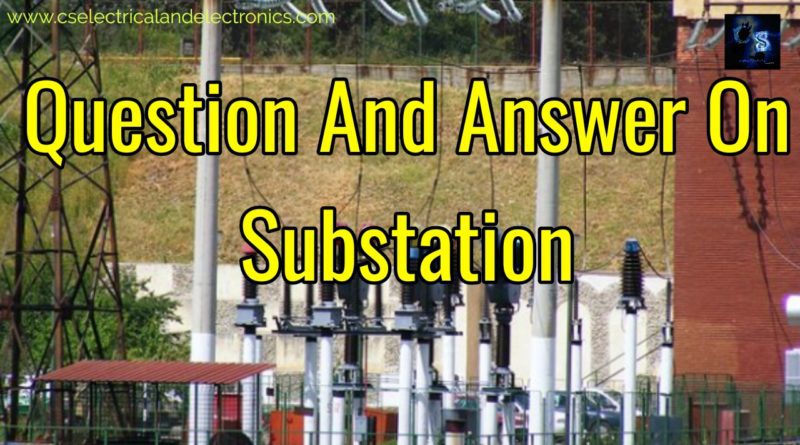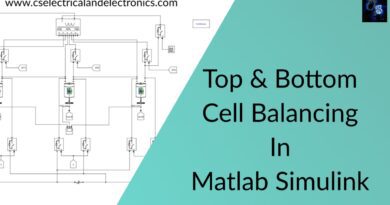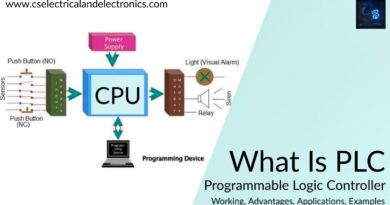50+ Question And Answer On The Substation, Electrical Question
Hello Guys, welcome back to my blog. In this article, I will discuss the 50+ question and answer on the substation, electrical interview questions with answers.
If you want an article on other topics, comment us below. You can also catch me @ Instagram – Chetan Shidling.
Also read – Switchgear And Protection Questions And Answers. and I will discuss the question and answer on the substation.
Question And Answer On Sub-station
01. Give the sequence of operations during the opening and closing of a circuit?
A. The sequence of operations during the opening and closing of the circuit is given below.
- During Opening – First open circuit breaker, open isolator, and then close earthing switch is provided.
- During Closing – First open earthing switch, close isolator, and then close the circuit breaker.
02. In what way is an isolator different from an air-break switch?
A. Isolators are used to connect or disconnect the line only under no-load condition while air-break switches are used for making and breaking of the circuit under loaded condition. Air-break switches are provided with arc control devices.
03. What is a flexible bus?
A. The flexible bus consists of ACSR which is made from a number of strands. ACSR conductor is made by using aluminum and steel. The inner strands in the conductor are made of steel and outer side strands are made of aluminum.
04. List out the equipment’s used in substation?
A. The equipment’s used substations are lightning arresters, isolators, circuit breakers, current transformers, potential transformers, power transformer, bus bar, capacitor bank, reactors, battery bank, relays, earthing system, insulators and also control room.
05. State the relative merits of indoor and outdoor substations?
A. The merits of the indoor substation are less space is required, less maintenance, and control cable length, protection from lightning, flexibility in installation, no dust, and dirt.
06. Why are isolators necessarily provided on the supply side of the circuit breaker?
A. Isolators are necessarily provided on the supply side of the circuit breaker in order to ensure isolation of the circuit breaker from the live parts for the purpose of maintenance.
07. Name the interlockings provided with isolators?
A. The interlocking provided with isolators are :
- a. Interlocking between three poles for simultaneous operation.
- b. Interlocking with circuit breakers.
08. What is Substation?
A. Substation means which consists of a number of equipment used for switching, controlling, and changing some characteristics of parameters. The main purpose of the substation is to step down the voltage along with this it is also used for protection, switching, and controlling.
09. What is Capacitor Bank?
A. A capacitor bank is used to improve the power factor of the line.
10. What is the circuit breaker?
A. A circuit breaker is a device used for protection against overload and short circuit conditions. circuit breaker interrupts the line if overload and a short circuit occur. The circuit breakers used in substations are an SF6 circuit breaker, vacuum circuit breaker, air blast circuit breaker, etc.
11. What is the isolator?
A. An isolator is nothing but a switch it is used to interrupt circuits during the no-load condition.
12. What is the use of the series reactor?
A. The purpose of the reactor is to avoid short circuit current in a line.
13. What are the instrument transformers?
A. The instruments transformers used in the substation are :
a. Current Transformer b. Potential Transformer
14. What is the use of a current transformer?
A. The purpose of the current transformer is to measure the current of the line and the current transformer is also used for protection.
15. What is the use of a potential transformer?
A. The purpose of the potential transformer is to measure the voltage of the line.
16. Difference between isolator and circuit breaker?
A. Isolators are operated only at no load condition whereas circuit breaks can be operated under load conditions and no-load conditions.
17. Why is air blast circuit breaker noisy?
A. The air blast circuit breakers interrupt the circuit by blowing compressed air at supersonic speed across the opening contacts. The result is that very loud noise is produced. The noise accompanying the air blast is so loud that noise-suppression methods must be used when the breakers are installed near residential areas.
If you have any doubts on question and answer on the substation, comment below.
18. What does the nameplate of the circuit breaker indicate?
A. The nameplate on a circuit breaker usually indicates :
- a. The maximum steady current it carries.
- b. The maximum interrupting current.
- c. The maximum line voltage.
- d. The interrupting time in cycles.
19. What are the applications of the SF6 circuit breaker?
A. A typical SF6 circuit breaker consists of interrupter units each capable of dealing with currents up to 60 KA and voltage in the range of 50-80 KV. A number of units are connected based on the system voltage and all units are connected in series. SF6 circuit breakers are used for 115 KV to 230 KV voltages, power ratings 10 MVA to 20 MVA, and interrupting time less than 3 cycles.
20. The current chopping mainly occurs in?
A. It mainly occurs in an air blast circuit breaker.
21. What is the purpose of the circuit breaker?
A. Circuit interruption only.
22. The H.R.C fuses provide the best protection against?
A. Short-circuit
23. What is the contact resistance of the circuit breaker?
A. The contact resistance of the circuit breaker is 20 microfarad.
24. Why sparking occurs when switching off the load?
A. The sparking occurs while switching off the load because of high circuit inductance.
25. What will be the power factor of arc?
A. The arc voltage in a circuit breaker is in phase with arc current.
26. How the rating of the circuit breaker is decided?
A. The rating of the circuit breaker is decided based on the symmetrical fault.

27. When arc interruption takes place in an oil circuit breaker?
A. The arc interruption takes place in an oil circuit breaker when current goes through zero.
28. Name the circuit breaker which has high reliability and negligible maintenance?
A. The SF6 circuit breaker has high reliability and negligible maintenance.
29. Two fuse wire of the same metal has a fusing current of 10 amps and 15 amps, which has more diameter?
A. The fuse wire of 15 amps has more diameter.
30. The operating of the fuse is based on?
A. Heating effect of electric current.
31. What is the difference between overload and short circuit?
If you have any doubts on question and answer on the substation, comment below.
A. when a short circuit occurs, the fault point of the voltage is reduced to zero and abnormal current of high magnitude starts flowing through the network to the point of fault. On the other hand, an overload means loads will be greater than the desired value. under such conditions, the voltage at the overload point may be low, and will not be zero.
32. What is the symmetrical fault?
A. The symmetrical fault occurs when all three conductors of a three-phase line are brought together into a short-circuit condition. The symmetrical faults rarely occur in the power system. Experience shows that hardly 5% of overload line faults are symmetrical faults.
33. What is the difference between suspension type and strain type insulator?
A. The difference between suspension and strain type insulators is that suspension insulators are used when there are no diversions and also it is used in diversions, crossings, etc whereas strain insulators are used only at crossings, diversions, etc. Suspension insulator is always parallel to the tower and perpendicular to the ground whereas strain insulators are always parallel to the ground and perpendicular to the tower.
34. What is the full form of ACSR conductor?
A. The full form of ACSR conductor is Aluminium Conductor Steel Reinforced.
35. What is the purpose of a relay?
A. The purpose of the relay is to detect the fault and initiate the circuit breaker to interrupt the line. The relays used in the substation are impedance relay, electromagnetically type relay, etc.
36. How suspension and strain insulators are made?
A. The suspension and strain insulators are made by a connecting the number of disc insulator, disc insulators are connected in series with the metallic link. The 66 KV line has 6 disc insulators connected in series and 110 KV line has 11 disc insulators connected in series. Each disc insulator is manufactured for 11 KV voltage.
37. What are the types of substation?
A. The types of substations are indoor and outdoor substations.
38. What is the purpose of lightning arresters in substation?
A. The purpose of a lightning arrester is to avoid lightning tender, lightning arrester is always connected at the starting of the line. Suppose if we do not provide lightning arresters, then when lightning tender occurs it will damage all equipment in the substation and if power transformer gets damaged then replacing transformer cost will be more, so always lightning arrester is provided at the starting of the line for protection.
39. Which equipment comes first and last in substation?
A. first comes to a lightning arrester, then comes isolator, circuit breaker, isolator, instrument transformer, isolator, power transformer, feeder with a capacitor bank.
40. What is the control room in substation?
A. Control room means where the switching and controlling actions are done, monitor and recording the load consumed by the consumer, Taking LC, line clear, etc.
41. What is LC in substation?
A. LC means line clear if any city and areas electricity is removed for one hour that is done in substation called line clear.
42. What is the full form of GOS?
A. The full form of GOS is the gange operating switch.
43. What is the corona effect in lines?
A. Corona effect occurs in transmission lines, when corona occurs it will produce hissing noise, ozone gas and produces color. Corona effect can be reduced by using the ACSR conductor, the spacing between the conductor, bundle conductor, etc.
44. What is a bundle conductor?
A. When two or more conductor is used as a single conductor then it is called bundle conductor.
45. Different types of insulators used in substation?
A. The different types of insulators used in the substation are suspension type insulators, strain type, disc type insulators, etc.
46. What is the skin effect in line?
A. The skin effect means current starts flowing on a surface of the conductor, so to reduce skin effect ACSR conductors are used.
If you have any doubts on question and answer on the substation, comment below.
47. What is the full form of OTI and WTI?
A. The full form of OTI is the oil temperature indicator which is used in power transformer to check the temperature of the oil and WTI is a winding temperature indicator that is used in power transformer to check the temperature of the winding.
48. Why stones are used in substation?
A. The stones or ballast used in substation because of many reasons :
- a. To avoid storing water during rain.
- b. To avoid the coming of animals like snakes and other insects.
- c. To avoid growing of trees and plants in a substation.
- d. During changing the oil in the transformer there will be some chances of falling oil, due to oil falling on the ground, fire can take place but by using stones there will be no chance of fire.
- e. stones also provide mechanical support to the equipment.
49. What are the types of substations based on construction?
A. The types of a substation based on the construction are
- a. Indoor Substation
- b. Outdoor Substation
- c. Underground Substation
- d. Pole mounted substation
50. What is the full form of MUSS?
A. The full form of MUSS is Mater Unit Sub-Station.
51. Why substations are required?
A. The substation is used to step down the voltage which is coming from transmission lines and send the step-down voltage to the distribution transformer station which is located near the consumer.
52. What is a feeder?
A. The feeder is nothing but conductors that are used to connect the substation to the consumer where the electricity needs to be distributed.
53. What is the purpose of sheaths in cables?
A. The purpose of sheaths in the cable is to prevent the ingress of moisture.
54. Why should synchronous condensers be installed in substations?
A. The purpose of the synchronous condenser is to improve the power factor of the line, the synchronous condenser is nothing but a synchronous motor which is used to improve power factors. The synchronous motor acts as a synchronous condenser if it is not connected to the load and when more excitation is given to it then it acts like a synchronous condenser.
These are the 50+ question and answer on the substation. I hope this article may help you all a lot… If you have any question regarding this article”question and answer on substation” then comment below.
Thank You For Reading…… Bye
Tag: 50+ question and answer on the substation, Electrical Interview Questions With Answers.
Also, read:
- 10 Tips To Maintain Battery For Long Life, Battery Maintainance
- 10 Tips To Save Electricity Bills, Save Money By Saving Electricity
- 100 (AI) Artificial Intelligence Applications In The Automotive Industry
- 100 + Electrical Engineering Projects For Students, Engineers
- 1000+ Control System Quiz, Top MCQ On Control System
- 1000+ Electrical Machines Quiz, Top MCQs On Electrical Machines
- 1000+ MATLAB Simulink Projects For MTech, Engineering Students
- 50 Tips To Save Electricity At Home, Shop, Industry, Office
- 50+ Question And Answer On The Substation, Electrical Question
- 500+ Matlab Simulink Projects Ideas For Engineers, MTech, Diploma
- 500+ Projects For Diploma Electrical, Electronics Student, Diploma Project
- Active Cell Balancing Using A Flyback Converter Simulation In Matlab Simulink
- AI Artificial Intelligence Applications In Electric Vehicles | Future?
- AI Tools For Electronic Circuit Design, Which Is Best?
- Applications Of Artificial Intelligence (AI) In Renewable Energy
- Automotive Industry Or VLSI Chip Industry ? Which Is Best?
- Basic Electrical Engineering, Terms, Definitions, SI Unit, Formula
- Basic Electrical Quiz, Take Online Test On Basic Electrical, Electrical Quiz
- Battery C Rate Online Calculator With Time Calculation
- Battery Management Systems In Electric Vehicles, BMS Operations
Author Profile
- Chetu
- Interest's ~ Engineering | Entrepreneurship | Politics | History | Travelling | Content Writing | Technology | Cooking
Latest entries
 All PostsApril 19, 2024What Is Vector CANoe Tool, Why It Is Used In The Automotive Industry
All PostsApril 19, 2024What Is Vector CANoe Tool, Why It Is Used In The Automotive Industry All PostsApril 13, 2024What Is TCM, Transmission Control Module, Working, Purpose,
All PostsApril 13, 2024What Is TCM, Transmission Control Module, Working, Purpose, All PostsApril 12, 2024Top 100 HiL hardware in loop Interview Questions With Answers For Engineers
All PostsApril 12, 2024Top 100 HiL hardware in loop Interview Questions With Answers For Engineers All PostsMarch 22, 2024Driver Monitoring Systems In Vehicles, Working, Driver Sleepy Alert
All PostsMarch 22, 2024Driver Monitoring Systems In Vehicles, Working, Driver Sleepy Alert








